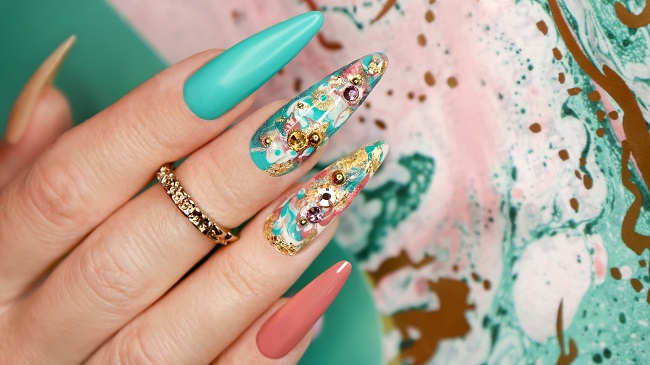Do you want to get rid of your acrylic nails? If so, you may be curious in alternatives to using acetone. Acetone, a strong chemical used to remove false nails, can irritate or even injure the skin if not administered correctly.
If you want to remove your acrylic nails at home but don’t have access to acetone, there are some excellent options you can try. In this article, we’ll discuss several tried-and-true techniques for taking off your fake nails without damaging your natural nails.

Contents
What is Acetone?
Acetone is a common solvent found in nail polish removers and other household cleaners. Propane-2-one, or dimethyl ketone, is another name for this compound. Acetone is used on fake nails primarily to remove the glue that holds them in place.
However, inappropriate or frequent use can dry out and harm your skin and nails. Some people find that the pungent odor of acetone gives them a headache.
Why Use Acetone?
Acetone is often used because it quickly and readily destroys the adhesive used to apply false nails. It is also useful for removing smudges and smears left by nail polish from the nail bed.
Use extreme caution while working with acetone, since it can cause skin discomfort or even harm, yet it removes acrylics rapidly and effectively. If you or someone you know has an allergy to acetone, it’s good to know what alternatives are out there.
How to Remove Acrylic Nails Without Acetone
The good news is that there are alternatives to acetone for removing fake nails. Some of the most efficient approaches are listed below.
1. Non-Acetone Nail Polish and False Nail Remover
The non-acetone alternative to acetone is an alcohol-based solution, and it is gentler on the skin. You can safely remove your artificial nails with a non-acetone remover without damaging your skin or nail bed.
False nails can still be removed with non-acetone nail polish removers, despite the fact that they contain milder chemicals. Keep in mind that they could potentially require more time than acetone.
Apply a thick layer of non-acetone remover directly to the surface of your acrylic nails and wait for the adhesive to disintegrate. As soon as that happens, you may simply pull off your false nails. Elegant Touch Nail Polish Remover Pads are our go-to because they get the job done without the use of harsh chemicals or acetone.
2. Warm Water
Acrylic nails can be removed with warm water instead of harsh chemicals if you want. Soap can be added to the mixture in very small amounts. Soak your nails for 20 minutes in the warm water before attempting to remove them. You might try to loosen the nails by wiggling them around in the water.
After waiting 20 minutes, you should be able to pull out the nails with the aid of an orange stick because the glue will have softened. If they still won’t budge after being soaked for an additional 10 minutes, you can try soaking them again and again until they are pliable enough to be removed.
3. Cuticle Nail
Use cuticle oil instead of acetone or isopropyl alcohol if you want to avoid potentially harmful substances. Using something that will nourish and restore your nails rather than strip them and cause harm is obviously preferable.
A saturated Q-tip can be held on each nail for around five minutes, with the oil being rubbed under the nail at any lifting points. One speedier method is to soak a cotton ball in oil and then either hold it in place or wrap it in tape or tin foil until the nail is loosened enough to be removed with an orange stick.
4. Dental Floss
Look no farther than this novel approach to removing acrylic nails with dental floss! If your acrylic nails have already begun to loosen, you can use this technique with greater success. If not, you might try soaking your hands in hot water or applying cuticle oil to release them.
It is extremely unlikely that you will succeed without the assistance of a friend. A cuticle stick can be used to pry up the nail’s edges so that dental floss can be inserted under the false nail once it has become loose.
Instruct your helper to work the floss back and forth along the nail until the entire nail is loosened and can be popped off. You should buff your nails, use cuticle oil, and moisturize after using this approach to help repair any damage and nourish your nails.
Conclusion
Acrylic nails are a great way to enhance your manicure and make a statement. However, they are challenging to eliminate. The above-mentioned simple tips, however, should address any concerns you may have had about the removal of artificial nails at home.
Acrylic nails may be removed quickly and easily using acetone. If you want to avoid damaging your nails when removing acrylics, follow these guidelines. If you want your nails to look and feel their best, follow the listed TLC. Following these steps will allow you to use acrylics without damaging your nails.






























